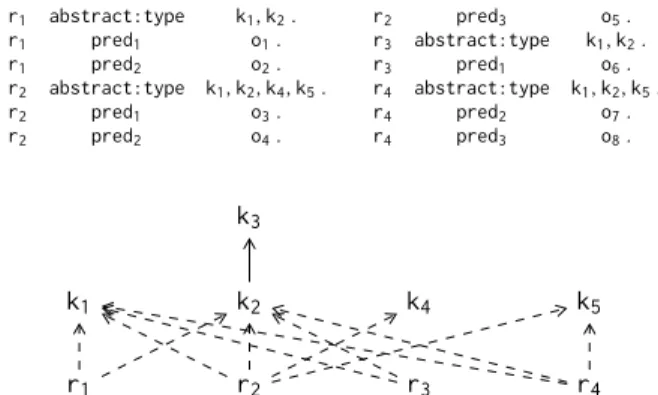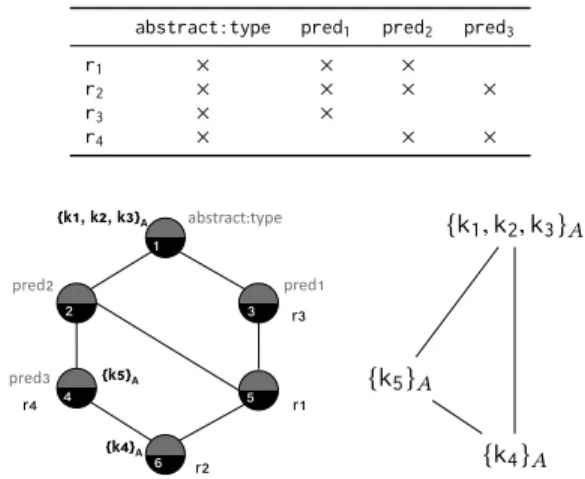HAL Id: hal-01671454
https://hal.inria.fr/hal-01671454v2
Submitted on 11 Dec 2018
HAL is a multi-disciplinary open access
archive for the deposit and dissemination of
sci-entific research documents, whether they are
pub-lished or not. The documents may come from
teaching and research institutions in France or
abroad, or from public or private research centers.
L’archive ouverte pluridisciplinaire HAL, est
destinée au dépôt et à la diffusion de documents
scientifiques de niveau recherche, publiés ou non,
émanant des établissements d’enseignement et de
recherche français ou étrangers, des laboratoires
publics ou privés.
Discovering Subsumption Axioms with Concept
Annotation
Pierre Monnin, Amedeo Napoli, Adrien Coulet
To cite this version:
Pierre Monnin, Amedeo Napoli, Adrien Coulet. Discovering Subsumption Axioms with Concept
Annotation. BDA 2017 - 33ème Conférence sur la Gestion de Données - Principes, Technologies et
Applications, Nov 2017, Nancy, France. Gestion de Données - Principes, Technologies et Applications
(BDA 2017). �hal-01671454v2�
Discovering Subsumption Axioms with Concept Annotation
Découverte d’axiomes de subsomption avec l’annotation de concepts
Pierre Monnin
LORIA (CNRS, Inria Nancy-Grand Est, Université de Lorraine) Campus Scientifique BP 239 Vandœuvre-Lès-Nancy, France 54506
pierre.monnin@loria.fr
Amedeo Napoli
LORIA (CNRS, Inria Nancy-Grand Est, Université de Lorraine) Campus Scientifique BP 239 Vandœuvre-Lès-Nancy, France 54506
amedeo.napoli@loria.fr
Adrien Coulet
LORIA (CNRS, Inria Nancy-Grand Est, Université de Lorraine) Campus Scientifique BP 239 Vandœuvre-Lès-Nancy, France 54506
adrien.coulet@loria.fr
CCS CONCEPTS
• Information systems → Data mining; Resource Descrip-tion Framework (RDF); Ontologies; • Computing methodolo-gies → Ontology engineering;
KEYWORDS
Linked Open Data, Formal Concept Analysis, Concept Annotation, ontology engineering
1
INTRODUCTION
Linked Open Data (LOD) consist of a large and growing collection of inter-domain data sets represented using Semantic Web standards including the use of RDF (Resource Description Framework) and URIs (Uniform Resource Identifiers) [1]. In LOD, resources can represent entities of the real world (e.g., persons, organizations, places) and are identified with a URI. RDF statements use predicates to link resources to other resources (from the same data set or from other data sets), to literals (e.g., strings, integers) or to classes of an ontology (class instantiation). Here, an ontology is a formal representation of a particular domain that consist of classes and relationships between them [3]. Among these relationships, we focus our work on the subsumption relation, stating that a class is more specific than another.
Available ontologies and LOD data sets are of various quality and completeness. In this paper, we propose to complete an ontology by discovering subsumption axioms between classes based on the regularities in a data set whose resources are linked to classes of the ontology. Particularly, we present and extend preliminary results published by the authors [6]. Formal Concept Analysis, a mathematical framework, is used to build a hierarchical structure called lattice representing the regularities between RDF resources and the predicates they are subject of. Concept Annotation is then applied on this structure to introduce ontology classes. This two-step process allows to discover subsumption axioms considering only the regularities in the data set.
2
LINKED OPEN DATA AND ONTOLOGIES
LOD are represented in the form of graphs encoded using RDF. The atomic element of an RDF graph is a triple denoted by: ⟨subject,
© 2018, Copyright is with the authors. Published in the Proceedings of the BDA 2017 Conference (14-17 November 2017, Nancy, France). Distribution of this paper is permitted under the terms of the Creative Commons license CC-by-nc-nd 4.0. © 2018, Droits restant aux auteurs. Publié dans les actes de la conférence BDA 2017 (14 au 17 novembre 2017, Nancy, France). Redistribution de cet article autorisée selon les termes de la licence Creative Commons CC-by-nc-nd 4.0.
Table 1: Example of RDF triples, represented with the Turtle syntax. r1 abstract:type k1, k2. r1 pred1 o1. r1 pred2 o2. r2 abstract:type k1, k2, k4, k5. r2 pred1 o3. r2 pred2 o4. r2 pred3 o5. r3 abstract:type k1, k2. r3 pred1 o6. r4 abstract:type k1, k2, k5. r4 pred2 o7. r4 pred3 o8. r1 r2 r3 r4 k1 k2 k4 k5 k3
Figure 1: Example of ontology classes being instantiated by resources. Instantiations are represented using dotted ar-rows and subsumption relations using solid arar-rows. For ex-ample, r1instantiates k1and k2, and k2is subsumed by k3.
predicate, object ⟩ ∈ (U ∪ B) × (U ∪ B) × (U ∪ B ∪ L) where U is the set of URIs, L is the set of literals and B represent blank nodes. To illustrate our approach, we consider in this short article an abstract RDF data set (Table 1) along with an abstract ontology O (Figure 1). We denote COthe set of classes of O. We are interested in the
discovery of subsumption axioms. The subsumption relation is a transitive relation denoted by ⊑, where c ⊑ d means that every instance of c is also an instance of d. For the sake of abstraction, O uses abstract:subClassOf to express subsumption relations and abstract:typeto express instantiations.
We define the type of a resource r as the set of classes of O that r instantiates. Formally, type(r)= {c ∈ CO| ⟨r, abstract:type, c⟩}.
Accordingly to the definition of the subsumption, we define the extended type of r as the whole set of superclasses of the classes of type(r). Formally, extdtype(r) = type(r) ∪ {d ∈ CO | ∃c ∈
type(r), c ⊑ d}.
3
FORMAL CONCEPT ANALYSIS AND
CONCEPT ANNOTATION
Formal Concept Analysis (FCA) is a mathematical framework whose basics can be found in [2]. It is used to build a hierarchical structure called lattice that denotes the regularities in a considered data set. Indeed, from the LOD triples in Table 1, we propose the formal
BDA’17, November 2017, Nancy, France P. Monnin et al.
context in Table 2. It is noteworthy that only subjects and predicates are considered to build this context: a subject and a predicate are related in this context if and only if a RDF triple exists where the subject and the predicate appear together. Then, standard FCA may be applied to produce the lattice visible in Figure 2. Formal concepts (A, B) are formed by two sets: the extent A containing subjects and the intent B containing predicates. To link formal concepts with ontology classes, Concept Annotation [6] is applied to each of them. Considering a formal concept (A, B), its annotation is defined as A⋄ = Ñr ∈Aextdtype(r ). It represents the shared extended type
of subjects in A. Given two formal concepts (A1, B1) ⩽ (A2, B2),
as A1 ⊆ A2, we have A⋄2 ⊆ A⋄1. Therefore, the annotation can
be depicted using an extension of the reduced labeling applied on lattices [2]. We call the proper annotation of a concept its annotation excluding classes appearing in the annotation of its superconcepts. From the annotated lattice in Figure 2, subsumption axioms may then be discovered. Consider a concept (A, B), e.g., concept 6, and one of its covering superconcept (E, F ), e.g., concept 4. As in Figure 2, we denote A⋄A = {x1, x2, . . . , xp} (here, {k4}) and
EA⋄ = {y1, y2, . . . , yq} (here, {k5}) the proper annotations of the
two concepts. Then, consider two ontology classes xi ∈ A⋄Aand
yj ∈ EA⋄. By definition, xiappears in the extended type of all
sub-jects in A and yjappears in the extended type of all subjects in E.
As A ⊆ E, yjappears in the extended type of all subjects where
xialso appears. Moreover, yjalso appears in the extended type
of other subjects. Thus, we consider this as the discovery of a sub-sumption axiom stating that xiis subsumed by yj(here k4should
be subsumed by k5). This axiom is then compared with axioms
already defined in the ontology: (i) if xi⊑ yjis already explicitly
stated, this is a redundant axiom, (ii) if xi⊑ yjis not already stated,
but can be inferred, this is an inferable axiom and (iii) if xi⊑ yjis
neither already explicitly stated nor inferable, it is a new subsump-tion axiom that has been discovered. Here, the axiom k4⊑ k5is a
new axiom.
If one considers only the covering concepts during the discovery process, this may lead to miss some interesting axioms. For exam-ple, in Figure 2, as the proper annotation of concept 2 is empty, we cannot discover axioms when considering concept 4 and its superconcept. Therefore, we propose here to discover subsumption axioms from the induced order on annotations from the lattice, ob-tained by considering only the annotations ordered by set inclusion following the order between formal concepts. This induced order is represented, using the reduced labeling, on the right of Figure 2. Set inclusion is read from top to bottom. Thus, subsumption ax-ioms can be read from this reduced labeling from bottom to top, leading to discover more axioms: k5being subsumed by k1, k2and
k3and k4being subsumed by k1, k2and k3. Such axioms cannot
be discovered by only considering the covering concepts.
4
PERSPECTIVES
We ran preliminary experiments on DBpedia [5], a LOD data set built from Wikipedia. It is necessary to evaluate and compare the obtained results with results of other methods. The annotation allows to take into account a third dimension (ontology classes) when describing data, in addition to the first two dimensions (RDF subjects and their predicates). Therefore, Triadic Concept Analysis
Table 2: Formal context built from the RDF triples in Table 1. A cross in the table relates a subject and a predicate if and only if a RDF triple exists where the subject and the predi-cate appear together.
abstract:type pred1 pred2 pred3
r1 × × × r2 × × × × r3 × × r4 × × × abstract:type pred1 pred3 pred2 r1 r2 r4 r3 1 2 4 3 5 6 {k1, k2, k3}A {k5}A {k4}A {k1, k2, k3}A {k5}A {k4}A
Figure 2: On the left: line diagram representing the anno-tated concept lattice built from the formal context in Table 2 and the ontology in Figure 1. On the right: line diagram representing the induced order on annotations. The lattice and the induced order are displayed using the reduced label-ing extended to annotations. Subjects are depicted in black, predicates in grey and annotations are depicted by {·}A.
For-mal concepts are arbitrarily numbered from 1 to 6.
[4] could be considered for comparison as it is an extension of FCA that also introduces a third dimension in the description of data. Finally, it could also be interesting to compare these two methods with results obtained using standard FCA. Indeed, because of its two-dimensional model for data description, predicates and ontology classes can only be mixed in one dimension.
ACKNOWLEDGMENTS
This work is supported by the PractiKPharma project, founded by the French National Research Agency (ANR) under Grant No.: ANR-15-CE23-0028 (http://practikpharma.loria.fr/), and by the Snowball Inria Associate Team (http://snowflake.loria.fr/).
REFERENCES
[1] Christian Bizer, Tom Heath, and Tim Berners-Lee. 2009. Linked Data - The Story So Far. Int. J. Semantic Web Inf. Syst. 5, 3 (2009), 1–22.
[2] Bernhard Ganter and Rudolf Wille. 1999. Formal Concept Analysis: Mathematical Foundations. Springer.
[3] Thomas R Gruber et al. 1993. A translation approach to portable ontology specifications. Knowledge acquisition 5, 2 (1993), 199–220.
[4] Fritz Lehmann and Rudolf Wille. 1995. A triadic approach to formal concept analysis. Conceptual structures: applications, implementation and theory (1995), 32–43.
[5] Jens Lehmann and et al. 2015. DBpedia - A large-scale, multilingual knowledge base extracted from Wikipedia. Semantic Web 6, 2 (2015), 167–195. https://doi. org/10.3233/SW-140134
[6] Pierre Monnin, Mario Lezoche, Amedeo Napoli, and Adrien Coulet. 2017. Using Formal Concept Analysis for Checking the Structure of an Ontology in LOD: The Example of DBpedia. In Foundations of Intelligent Systems - 23rd International Symposium, ISMIS 2017, Warsaw, Poland, June 26-29, 2017, Proceedings. 674–683. https://doi.org/10.1007/978-3-319-60438-1_66

